Signals That It's Time To Remove A Tree: Identifying Unsafe Trees
Signals That It's Time To Remove A Tree: Identifying Unsafe Trees
Blog Article
Composed By-Harper Goodman
When it concerns tree treatment, identifying the indicators that it's time for elimination is necessary for your security and residential or commercial property. You could observe blemished fallen leaves, wilting branches, or strange fungal growths showing health problems. Structural problems, like a considerable lean or fractures in the trunk, can additionally present risks. Comprehending these indication can help you make educated decisions about your trees and protect against potential dangers lurking in your yard. What should you seek following?
Indicators of Degeneration and Condition
When you discover indicators of degeneration and illness in your trees, it's vital to act quickly. Try to find stained fallen leaves, wilting branches, or unusual developments like fungus. These can indicate that your tree is struggling.
If you see cracks in the bark or soft, mushy timber, these signs recommend internal degeneration. Furthermore, an abrupt rise in parasites around your tree can indicate that it's damaged and vulnerable.
Look for How To Remove Ivy From Trees or dying limbs, as they pose a risk to your home and safety. If you doubt regarding what you see, getting in touch with an arborist can give quality.
Dealing with these indications early can save you from much more substantial damages and ensure the health of your backyard. Don't wait till it's too late.
Structural Instability and Leaning
As you observe your trees, watch out for any indications of architectural instability or leaning. If a tree leans dramatically, it may show that the origin system is endangered.
Seek any type of splits in the trunk or dirt around the base; these can indicate possible failing. Furthermore, look for unusual development patterns, like an unbalanced crown, which may suggest that the tree is battling to hold itself upright.
If you discover that the tree leans toward your home, power lines, or various other structures, it presents a better danger. Do not overlook these signs-- speak with an arborist to evaluate the situation.
Taking action early can avoid pricey damage and ensure your security.
Dead or Dying Branches and Vegetation
If you see dead or passing away branches and foliage on your tree, it's a clear indicator that something's incorrect.
These harmful areas can suggest underlying issues like illness, pest problems, or ecological tension. When branches lose their leaves or transform brownish, they're no more adding to the tree's wellness. Disregarding these signs could cause further decrease, making your tree more hazardous.
Dead branches can quickly break short during storms, posturing a risk to residential property and individuals close by. Read Far more to examine the level of the damage.
If the trouble impacts a significant part of the tree, consider speaking with an expert. They can aid identify if elimination is needed to make certain safety and keep the elegance of your landscape.
Conclusion
If you see any type of signs of decay, structural instability, or dead branches on your trees, don't ignore them. These indicators can position major safety threats to you and your home. It's always best to seek advice from a specialist arborist that can provide a professional evaluation of your trees. Doing something about it early can protect against crashes and costly damages, guaranteeing your landscape remains safe and healthy. Remember, it's far better to be aggressive concerning tree treatment than to wait on a calamity to occur.
